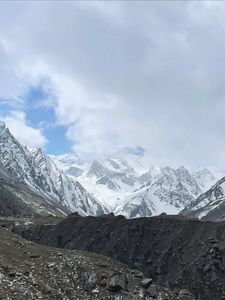Top 6 Himalayan Destinations Where Mountains and Mythology Meet
 Aakash Rawat
07 Aug, 2025
7 mins read
27
Aakash Rawat
07 Aug, 2025
7 mins read
27

The Himalayas are not just a range of mountains they are living legends. For thousands of years, these peaks have been more than natural wonders; they’ve been sacred spaces, silent witnesses to epics, and homes to gods in the Indian imagination. Every valley, river, and trail here carries stories that are woven into the fabric of Indian mythology. From the Mahabharata to ancient Himalayan folklore, these mountains have been deeply rooted in spiritual life and belief systems that are still alive today.
What makes these places truly special is that the journey to reach them often feels as meaningful as the destination itself. Unlike tourist spots filled with crowds and cameras, these trails are quieter, more soulful. They test your body, still your mind, and open your heart. Whether you're walking toward a snow-covered peak believed to be Shiva’s dwelling or visiting a remote temple where gods are said to have meditated, each step is filled with purpose. These are not just treks or visits they’re experiences that connect you to something timeless. And if you’re someone who seeks that blend of nature and spiritual depth, here are six Himalayan destinations that offer exactly that.
1. Adi Kailash and Om Parvat, Uttarakhand
Mythological Significance: Known as “Chhota Kailash,†Adi Kailash is considered an earthly replica of Mount Kailash in Tibet. It is believed to be the abode of Lord Shiva and Parvati. Nearby Om Parvat displays a natural snow formation shaped like the sacred ‘Om’ symbol.
Why it’s special:
- Remote and less commercial than other pilgrimages
- The journey itself is part of the spiritual experience
- Connects you with ancient Himalayan traditions and stories
Best Time to Visit: May to October
2. Kedarnath, Uttarakhand
Mythological Significance: One of the twelve Jyotirlingas, Kedarnath is a sacred temple dedicated to Lord Shiva. Legend says it was built by the Pandavas after the Kurukshetra war as an act of penance.
Why it’s special:
- Surrounded by snow-covered peaks
- Reached via a high-altitude trek
- Deep spiritual atmosphere, especially at dawn and dusk
Best Time to Visit: May to June, September to October
3. Hemkund Sahib and Lokpal Lake, Uttarakhand
Mythological Significance: Hemkund Sahib is a sacred Sikh shrine believed to be where Guru Gobind Singh meditated in a past life. Nearby, Lokpal Lake is tied to stories of Lakshman from the Ramayana.
Why it’s special:
- Blend of Sikh and Hindu mythology
- High-altitude lake surrounded by wildflowers
- Steep, but rewarding trek through the Valley of Flowers region
Best Time to Visit: June to September
4. Mount Kinner Kailash, Himachal Pradesh
Mythological Significance: This sacred mountain is believed to be the winter abode of Lord Shiva and Parvati. It is said the divine couple held court here when snow covered Mount Kailash in Tibet.
Why it’s special:
- The trek to the Shivling rock formation is both challenging and symbolic
- Offers panoramic views of the Kinnaur and Spiti ranges
- Deep spiritual pull, especially during the Kinnaur Kailash Yatra
Best Time to Visit: July to September
5. Tungnath and Chandrashila, Uttarakhand
Mythological Significance: Tungnath is the highest Shiva temple in the world, part of the Panch Kedar. It is believed that Lord Shiva’s arms appeared here after the Mahabharata.
Why it’s special:
- Short trek suitable for beginners
- Chandrashila peak offers one of the best panoramic Himalayan views
- Legend says Lord Rama meditated here after defeating Ravana
Best Time to Visit: April to November
6. Amarnath Cave, Jammu & Kashmir
Mythological Significance: One of the holiest Hindu shrines, this cave is where Shiva is believed to have revealed the secret of immortality to Parvati. The naturally forming ice lingam inside the cave is worshipped as a representation of Shiva.
Why it’s special:
- Pilgrimage of endurance and devotion
- Surrounded by awe-inspiring snow valleys
- Spiritual energy that pulls thousands every year
Best Time to Visit: July to August (during Amarnath Yatra)
Final Thoughts
These destinations are not just about reaching a spot or ticking off a trail. They're about the stories the land tells, the quiet moments you feel, and the ancient energies that still linger in the rocks, rivers, and skies. Whether you're on a pilgrimage or just a curious traveler, these Himalayan sites offer something deeper a chance to walk where gods are said to have walked, and to listen where silence says more than words ever could.
Written By:
Aakash Rawat



Hotels at your convenience
Now choose your stay according to your preference. From finding a place for your dream destination or a mere weekend getaway to business accommodations or brief stay, we have got you covered. Explore hotels as per your mood.


